|
This is a name which was carried over the Wallace Line from the Philippines into the Western Pacific and ultimately to the northern and southern extremes of Polynesia, along with plants of the much-esteemed Tī-pore, Cordyline fruticosa. It almost certainly reached Easter Island too, but unfortunately neither the name nor the plants survived there.
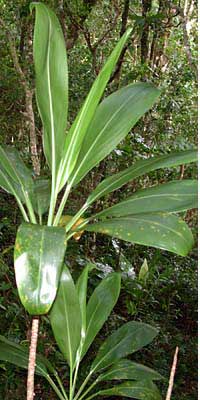 There are five indigenous species of tī in Aotearoa and two species that have long been cultivated here: Cordyline fruticosa which was brought by the first Polynesian settlers (illustrated on the left), and Cordyline rubra, which was a very early introduction, possibly also by Māori, in this case returning from visits to Australia in the early 19th Century (the New Zealand Plant Conservation Network database refers to this species as "Probably horticultural - however it arrived here rather early in New Zealand's recorded history. It is possibly partly indigenous.") There are five indigenous species of tī in Aotearoa and two species that have long been cultivated here: Cordyline fruticosa which was brought by the first Polynesian settlers (illustrated on the left), and Cordyline rubra, which was a very early introduction, possibly also by Māori, in this case returning from visits to Australia in the early 19th Century (the New Zealand Plant Conservation Network database refers to this species as "Probably horticultural - however it arrived here rather early in New Zealand's recorded history. It is possibly partly indigenous.")
It was only about the time I was first developing this website that I discovered, thanks to a specialist at the Auckland Museum, that plants which we had carried carefully in turn to our homes in Wellington, Auckland and the Waikato from our family property in Russell, thinking they were remnants of C. fruticosa, were in fact C. rubra (with which they are easily confused, but true C. fruticosa have wider leaves). We also have plants of this species from old-established groves on Waiheke Island and from abandoned Māori settlements in the Auckland area. Despite the real Cordyline fruticosa's having formerly been widely cultivated in the North, apparently very few plants descended from the original Polynesian introductions survive. In the Kermadec Islands, however, the warmer climate enabled the early Polynesian introductions to integrate with the indigenous ecosystem, so they have been part of the Kermadec flora for the last five centuries or more.
The variety of Cordyline fruticosa traditionally cultivated in Eastern Polynesia is green-leaved and generally sterile; it also flowers infrequently, so is propagated mainly by side-shoots and cuttings. This is the variety brought to Aotearoa. The ornamental varieties cultivated horticulturally in Hawaii and other parts of Eastern Polynesia are probably mostly based on later introductions from the West.
As a group, these trees are characterized by having an underground rhizome which acts as an anchoring root and also a store of both energy and buds to enable the plant to sprout anew if the trunk is damaged. This, and the ability to regenerate from severed branches, fallen trunks, or even chips of bark, give the plant tremendous resilience. New Zealand trees, especially C. australis and C. banksii, have been subjected to fatal attacks by a phytoplasma (a kind of bacterium) which attacks the food-conducting tissues and blocks the water-conducting ones, causing the plant to die, sometimes within a few weeks, sometimes over a whole year. Once the plant is infected this seems generally to be irreversable, although if cut down promptly enough it may sprout again from the base; that may also happen spontaneously, but normally the tree dies off completely. At the beginning of the 21st Century the future for these trees in New Zealand looked very grim -- it seemed that the leaf hoppers which were spreading the bacteria (which also sporadically attacks harakeke) were finishing off what people had started through clearing land and reducing the native habitats of these plants. However the decline seems to have debated somewhat in recent years. We have lost quite a few large trees growing in more open environments in Te Māra Reo (including those photographed for this page), also all the plants of the red-leaved cultivar, but others, especially those growing among other trees, are still thriving.
The indigenous species, with their Māori names (some of which almost certainly refer to particular varieties), are:
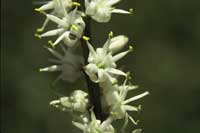 Cordyline australis (tī-kāuka, tī-kōuka, tī-awe, kiokio, kiokio tūpare, tī-para, tī-pua, tī-rākau, tī-whanake). This iconic tree ultimately grows up to between 12 and 20 metres in height with a trunk up to 1.5 metres through. It is found naturally on the margins of forest and around swamps, and also colonizes clearings. The masses of beautifully scented flowers are borne in late spring and summer. Individual trees can live for over a hundred years, and sprout from the buds waiting to be activated in the underground rhizome at the base when the main stem is finally exhausted. A circle of Tī-kōuka in an isolated spot generally indicates that regeneration of this kind has happened. Unfortunately, because the young shoots are so palatible to grazing animals, often only older trees will remain alive, and this once abundant tree is becoming endangered in many of its old habitats. Cordyline australis (tī-kāuka, tī-kōuka, tī-awe, kiokio, kiokio tūpare, tī-para, tī-pua, tī-rākau, tī-whanake). This iconic tree ultimately grows up to between 12 and 20 metres in height with a trunk up to 1.5 metres through. It is found naturally on the margins of forest and around swamps, and also colonizes clearings. The masses of beautifully scented flowers are borne in late spring and summer. Individual trees can live for over a hundred years, and sprout from the buds waiting to be activated in the underground rhizome at the base when the main stem is finally exhausted. A circle of Tī-kōuka in an isolated spot generally indicates that regeneration of this kind has happened. Unfortunately, because the young shoots are so palatible to grazing animals, often only older trees will remain alive, and this once abundant tree is becoming endangered in many of its old habitats.
There is a cultivated dwarf weak-stemmed variety of C. australis known as tī para or tī tawhiti which was propagated by Māori for its especially tender and sweet rhizomes, in the same way that the green-leaved variety of C. fruticosa had been selected by the settlers of East Polynesia as a food plant.
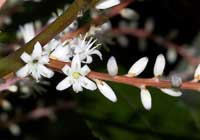 Cordyline banksii (tī-ngahere, hauora, tī-kapu, tī-ngahere, tī-pārae, tī-torere, turuki). This is the forest cabbage tree, found along forest margins and also among rocks in places where there is a high rainfall. It grows to about 4 metres, and often has multiple trunks. Seedlings are slow growing, and may take several years before they begin forming their slender trunks, only about 10-15 cm in diameter, a striking contrast to the massive stems often developed by older specimens of the the tī-kōuka (Cordyline australis). Cordyline banksii (tī-ngahere, hauora, tī-kapu, tī-ngahere, tī-pārae, tī-torere, turuki). This is the forest cabbage tree, found along forest margins and also among rocks in places where there is a high rainfall. It grows to about 4 metres, and often has multiple trunks. Seedlings are slow growing, and may take several years before they begin forming their slender trunks, only about 10-15 cm in diameter, a striking contrast to the massive stems often developed by older specimens of the the tī-kōuka (Cordyline australis).
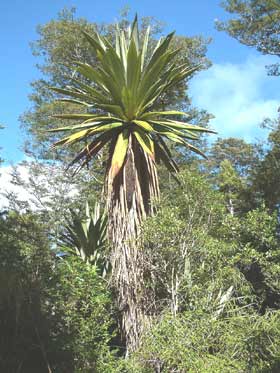 Cordyline indivisa (ti, tī-kapu, tī-kupenga, tī-mataku-tai). This beautiful tree with its leaves up to 2 metres long and 15 centimetres wide grows to 8 metres or so high, generally unbranched. Its flowers are born in tightly-packed panicles, almost like bunches of bananas. It is a plant of the mountains, luxuriating in rich soils in areas where there is a lot of rain and mist. (See the page for Tōī for more information about this tree.) Cordyline indivisa (ti, tī-kapu, tī-kupenga, tī-mataku-tai). This beautiful tree with its leaves up to 2 metres long and 15 centimetres wide grows to 8 metres or so high, generally unbranched. Its flowers are born in tightly-packed panicles, almost like bunches of bananas. It is a plant of the mountains, luxuriating in rich soils in areas where there is a lot of rain and mist. (See the page for Tōī for more information about this tree.)
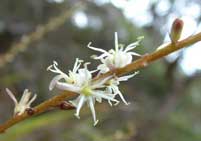 Cordyline pumilio (tī-koraha, mauku, kōuapua, korokio, tī-rauriki). This is a small grass-like plant which grows close to the ground. Young plants when not in flower are easily mistaken for grasses or sedges; older plants may have a very slim trunk with leaves to ground level at first, the bare trunk up to a metre high with a tuft of leaves narrow (1-2 cm. wide) and up to a metre long at the top. It flowers profusely, like most of the other tī, even when very young, bearing its strongly scented flowers in long, open panicles. It is found in open forest and scrubland from the Waikato and Bay of Plenty north. Cordyline pumilio (tī-koraha, mauku, kōuapua, korokio, tī-rauriki). This is a small grass-like plant which grows close to the ground. Young plants when not in flower are easily mistaken for grasses or sedges; older plants may have a very slim trunk with leaves to ground level at first, the bare trunk up to a metre high with a tuft of leaves narrow (1-2 cm. wide) and up to a metre long at the top. It flowers profusely, like most of the other tī, even when very young, bearing its strongly scented flowers in long, open panicles. It is found in open forest and scrubland from the Waikato and Bay of Plenty north.
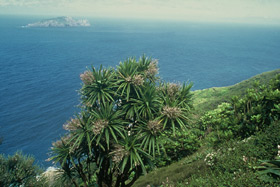 Cordyline obtecta (tī). This is the Kermadec Island tī; it is also found natively in the very far north of the North Island and the Poor Knights islands, as well as on Norfolk Island. The tree grows to 4 metres high with a short trunk and many branches (several trunks may arise from the same rhizome). The yellow-green leaves are about two feet long; unlike some of the other species of Cordyline, the midrib is not prominent. It has small white fruit. This species has had several name changes and consolidations. The Aotearoa-based plants have been known as C. kaspar and the Norfolk Island plants as C. baueri; the Norfolk plants were the first to be formally described and since they were found to be identical with the Kermadec ones, the specific name is now based on that given in the first formal description of the plant (as Dracaena obtecta) in 1827. Cordyline obtecta (tī). This is the Kermadec Island tī; it is also found natively in the very far north of the North Island and the Poor Knights islands, as well as on Norfolk Island. The tree grows to 4 metres high with a short trunk and many branches (several trunks may arise from the same rhizome). The yellow-green leaves are about two feet long; unlike some of the other species of Cordyline, the midrib is not prominent. It has small white fruit. This species has had several name changes and consolidations. The Aotearoa-based plants have been known as C. kaspar and the Norfolk Island plants as C. baueri; the Norfolk plants were the first to be formally described and since they were found to be identical with the Kermadec ones, the specific name is now based on that given in the first formal description of the plant (as Dracaena obtecta) in 1827.
The young shoots, roots (i.e. rhizomes), and the inner part of the trunk of all these species can be prepared for eating, but the rhizome of the Ti-pore, C. fruticosa, was particularly esteemed because of its high sugar content.
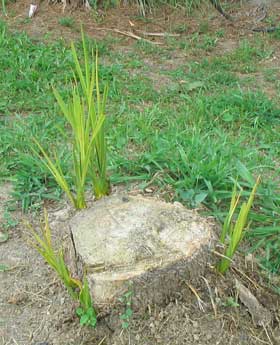 There are numerous proverbs referring to the tī, especially because of its ability to regenerate from the base or a chip off the trunk after it has been cut down -- as with the resurgent stump in the photograph on the left. Elsdon Best quotes several of them in his Forest Lore of the Māori (p. 87): There are numerous proverbs referring to the tī, especially because of its ability to regenerate from the base or a chip off the trunk after it has been cut down -- as with the resurgent stump in the photograph on the left. Elsdon Best quotes several of them in his Forest Lore of the Māori (p. 87):
He uru a kī, he uru tī, e pihi ake.
A grove of words, a grove of tī, both shoot up. (That is, be careful what you say, your words may take off on their own!)
Ka whati te tī, ka wana te tī, ka rito te tī.
The tī is broken off, the tī puts out new shoots, the tī regains its crown. (Mead & Grove [#1214] interpret this as a comment on inevitability, contrasting the vulnerability of people with the resilience of the tī.)
Ehara i te tī e wana ake.
It's
not as if he's a tī that will sprout again. (A reason for mourning the dead)
|
Photographs: The sources of the photographs in the galleries are acknowledged in the captions. The inset photos in the text are, in order, [1] Cordyline fruticosa, Rarotonga, (c) Gerald McCormack, CIBP; [2] Flowers of C. australis, (c) Gillian Crowcroft, NZPCN; [3] Flowers of C. banksii (c) Jeremy Rolfe; [4] C. indivisa, Whakapapa, Ruapehu, and [5] Flowers of C. pumilo, John Smith-Dodsworth (c) NZPCN; [6] C. obtecta, Manawatahi Island, Kermadecs (Dept of Conservation); [7] Regenerating base of C. australis, Te Māra Reo. There is a story attached to the last picture: it was taken a few weeks after vandals had cut down the original tree on the road side of the gateway. One of the shoots eventually developed into a well-grown tree, only to meet its fate some years later in the maw of a digger during a road-widening and drain-clearing exercise by the District Council. There are many striking photographs of specimens of all these plants on the NZPCN website.
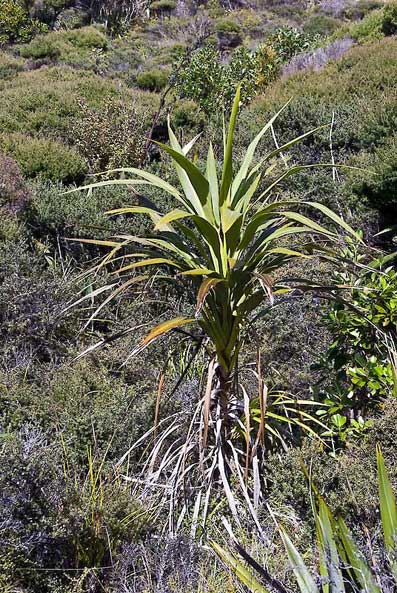
Cordyline obtecta - Tī
(North Cape. Photo: Jeremy Rolfe (c) NZPCN)
| 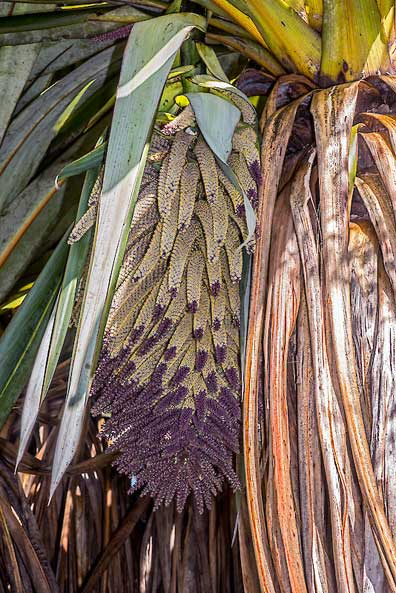
Cordyline indivisa - Tī-kupunga, Tōī (Inflorescence)
(Erua Forest, Ruapehu. Photo (c) Jeremy Rolfe, NZPCN) |
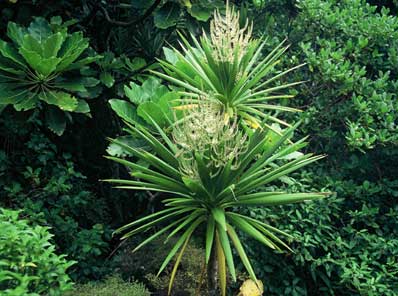
Cordyline obtecta - Tī (Tasman Valley, Great Isl., Kermadecs
(Photo: (c) Peter de Lange, NZPCN)
| 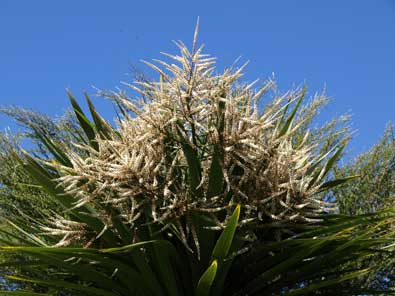
Cordyline australis - Tī, Tī-kōuka (Inflorescence)
(Te Māra Reo) |
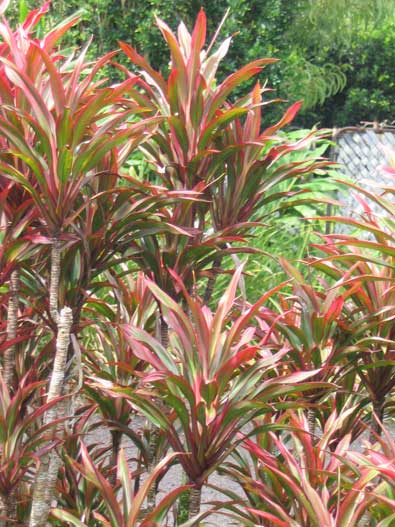
Cultivated Cordyline - Tī , looking very like C. rubra
(Lyon Arboretum, Honolulu. Photo: R.B.)
| 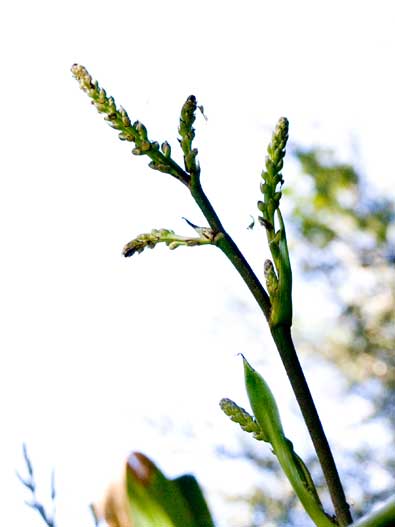
Cordyline rubra - Tī (Developing inflorescence)
(Te Māra Reo) |
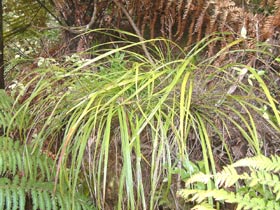
Cordyline pumilo - Tī-koraha
(Coromandel. Photo: John Smith-Dodsworth (c) NZPCN)
| 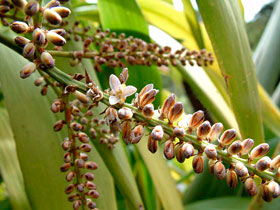
Cprdyline rubra - Tī (Inflorescence)
(Photo: (c) Jeremy Rolfe, NZPCN) |
|

